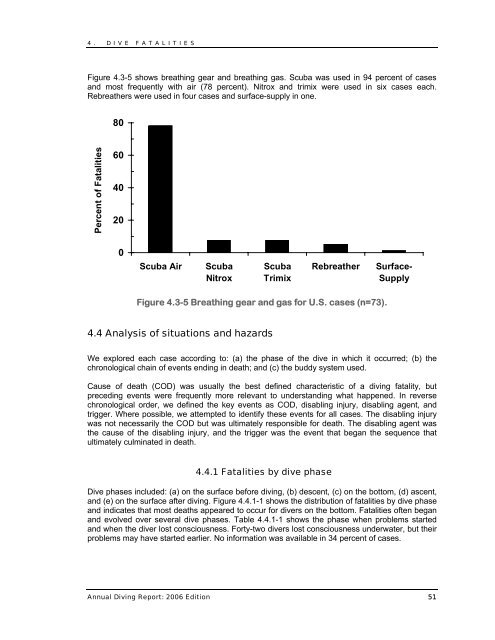Annual Diving Report - Divers Alert Network
Annual Diving Report - Divers Alert Network
Annual Diving Report - Divers Alert Network
Create successful ePaper yourself
Turn your PDF publications into a flip-book with our unique Google optimized e-Paper software.
4. DIVE FATALITIES<br />
Figure 4.3-5 shows breathing gear and breathing gas. Scuba was used in 94 percent of cases<br />
and most frequently with air (78 percent). Nitrox and trimix were used in six cases each.<br />
Rebreathers were used in four cases and surface-supply in one.<br />
Percent of Fatalities<br />
80<br />
60<br />
40<br />
20<br />
0<br />
Scuba Air Scuba<br />
Nitrox<br />
Scuba<br />
Trimix<br />
Rebreather Surface-<br />
Supply<br />
Figure 4.3-5 Breathing gear and gas for U.S. cases (n=73).<br />
4.4 Analysis of situations and hazards<br />
We explored each case according to: (a) the phase of the dive in which it occurred; (b) the<br />
chronological chain of events ending in death; and (c) the buddy system used.<br />
Cause of death (COD) was usually the best defined characteristic of a diving fatality, but<br />
preceding events were frequently more relevant to understanding what happened. In reverse<br />
chronological order, we defined the key events as COD, disabling injury, disabling agent, and<br />
trigger. Where possible, we attempted to identify these events for all cases. The disabling injury<br />
was not necessarily the COD but was ultimately responsible for death. The disabling agent was<br />
the cause of the disabling injury, and the trigger was the event that began the sequence that<br />
ultimately culminated in death.<br />
4.4.1 Fatalities by dive phase<br />
Dive phases included: (a) on the surface before diving, (b) descent, (c) on the bottom, (d) ascent,<br />
and (e) on the surface after diving. Figure 4.4.1-1 shows the distribution of fatalities by dive phase<br />
and indicates that most deaths appeared to occur for divers on the bottom. Fatalities often began<br />
and evolved over several dive phases. Table 4.4.1-1 shows the phase when problems started<br />
and when the diver lost consciousness. Forty-two divers lost consciousness underwater, but their<br />
problems may have started earlier. No information was available in 34 percent of cases.<br />
<strong>Annual</strong> <strong>Diving</strong> <strong>Report</strong>: 2006 Edition 51

















